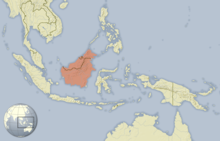Borneo porcupine
| Borneo porcupine | ||||||||||||
|---|---|---|---|---|---|---|---|---|---|---|---|---|

Borneo porcupine (drawing by C Berjeau from the Proceedings of the Zoological Society of London, 1876) |
||||||||||||
| Systematics | ||||||||||||
|
||||||||||||
| Scientific name | ||||||||||||
| Hystrix crassispinis | ||||||||||||
| Günther , 1877 |
The Borneo porcupine ( Hystrix crassispinis ) is a type of porcupine from the genus of the real porcupines ( Hystrix ). It is endemic to the island of Borneo .
features
The Borneo porcupine reaches a head and trunk length of 45.0 to 65.5 centimeters and the tail length is 6.5 to 19.0 centimeters, it reaches a weight of 3.8 to 5.4 kilograms. The hind foot becomes 80 to 90 millimeters long, the ear length is 35 to 42 millimeters. Like all real porcupines it is very large for a rodent and the largest species of the island porcupines (sub-genus Thecurus ), but only medium-sized within the genus Hystrix . The animal is brown in its basic color and has very thick spines, which is why it bears the common English name "Thick-spined Porcupine". Compared to the other island porcupines, it has the longest spines, the longest sensor posts and also the longest reshaped spines in the tail tassel. Due to the white spiked tips, however, it is speckled white on the cheeks, neck, shoulders and sides of the body, as well as partially on the back. The number of long feeler bristles is small. As with other species of island porcupine, they do not have a prickly comb on their head or front body. Some of the particularly long spines on the back reach lengths of about 25 to 65 millimeters and have white tips, others are shorter with black tips; The number of white-tipped spines exceeds that of the black-tipped ones. The diameter of the larger spines is up to 8.3 millimeters, making them thicker than those of other species of the subgenus Thecurus and Acanthion and comparable to those of the subgenus Hystrix . The spines in the area of the rear part of the body are dark brown with only narrow white tips and bases, the spines under the tail are brown and white. The tail is short and about 20% of the length of the head and torso, it has a tail tassel made of spines that have been transformed into a rattle. These hollow tubes are 12 to 16 millimeters long.
The Borneo porcupine differs from the Sumatran porcupine ( Hystrix sumatrae ) mainly in its size, the longer spines and bristles and the larger skull. The nasal bones are also formed a little longer in relation to the other bones.
distribution
The Borneo porcupine is endemic to the island of Borneo , which is shared by Indonesia , Malaysia and the Sultanate of Brunei .
Way of life
Very little information is available about the lifestyle of the Borneo porcupine. It occurs mainly in untouched primary forests as well as young and older secondary forests of the lowlands up to heights of 1200 meters in the east of Kalimantan . Like other porcupines, it is likely primarily herbivorous and there is no information available on reproduction or behavior.
Systematics
The Borneo porcupine is classified as a separate species within the genus of the real porcupines ( Hystrix ), which consists of eight species in Asia and Africa. The first scientific description comes from Albert Günther from 1877. He stated Borneo as the place of origin . Within the genus, the species is placed in the subgenus Thecurus , which is occasionally also considered a genus of its own. Sometimes the Sumatran porcupine ( Hystrix sumatrae ) was considered a subspecies of this species.
Apart from the nominate form, no subspecies are distinguished within the species .
Status, threat and protection
The Borneo porcupine is classified as Least Concern by the International Union for Conservation of Nature and Natural Resources (IUCN). This is justified with the comparatively large distribution area and its regular occurrence on Borneo. There are no known risks to the company's existence. The species is hunted locally as a source of meat, but this has little effect on the population.
supporting documents
- ^ A b A. Günther: Report on some of the additions to the Collection of Mammalia in the British Museum. In: Proceedings of the Zoological Society of London , Vol. 1876, pp. 735-751, 1877. (digitized version )
- ↑ a b c d e f g E.L. Barthelmess: Thick-spined Porcupine - Hystrix crassispinis. In: Don E. Wilson, TE Lacher, Jr., Russell A. Mittermeier (editors): Handbook of the Mammals of the World: Lagomorphs and Rodents 1. (HMW, Volume 6), Lynx Edicions, Barcelona 2016; P. 325. ISBN 978-84-941892-3-4 .
- ↑ a b c d Hystrix crassispinis in the IUCN Red List of Threatened Species 2017.2. Posted by: F. Cassola, 2008. Retrieved September 14, 2016.
- ↑ a b c Hystrix (Thecurus) crassispinis . In: Don E. Wilson , DeeAnn M. Reeder (Eds.): Mammal Species of the World. A taxonomic and geographic Reference. 2 volumes. 3. Edition. Johns Hopkins University Press, Baltimore MD 2005, ISBN 0-8018-8221-4 .
literature
- EL Barthelmess: Thick-spined Porcupine - Hystrix crassispinis. In: Don E. Wilson, TE Lacher, Jr., Russell A. Mittermeier (editors): Handbook of the Mammals of the World: Lagomorphs and Rodents 1. (HMW, Volume 6), Lynx Edicions, Barcelona 2016; P. 325. ISBN 978-84-941892-3-4 .
Web links
- Hystrix crassispinis inthe IUCN Red List of Threatened Species 2017.2. Posted by: F. Cassola, 2008. Retrieved September 14, 2016.
